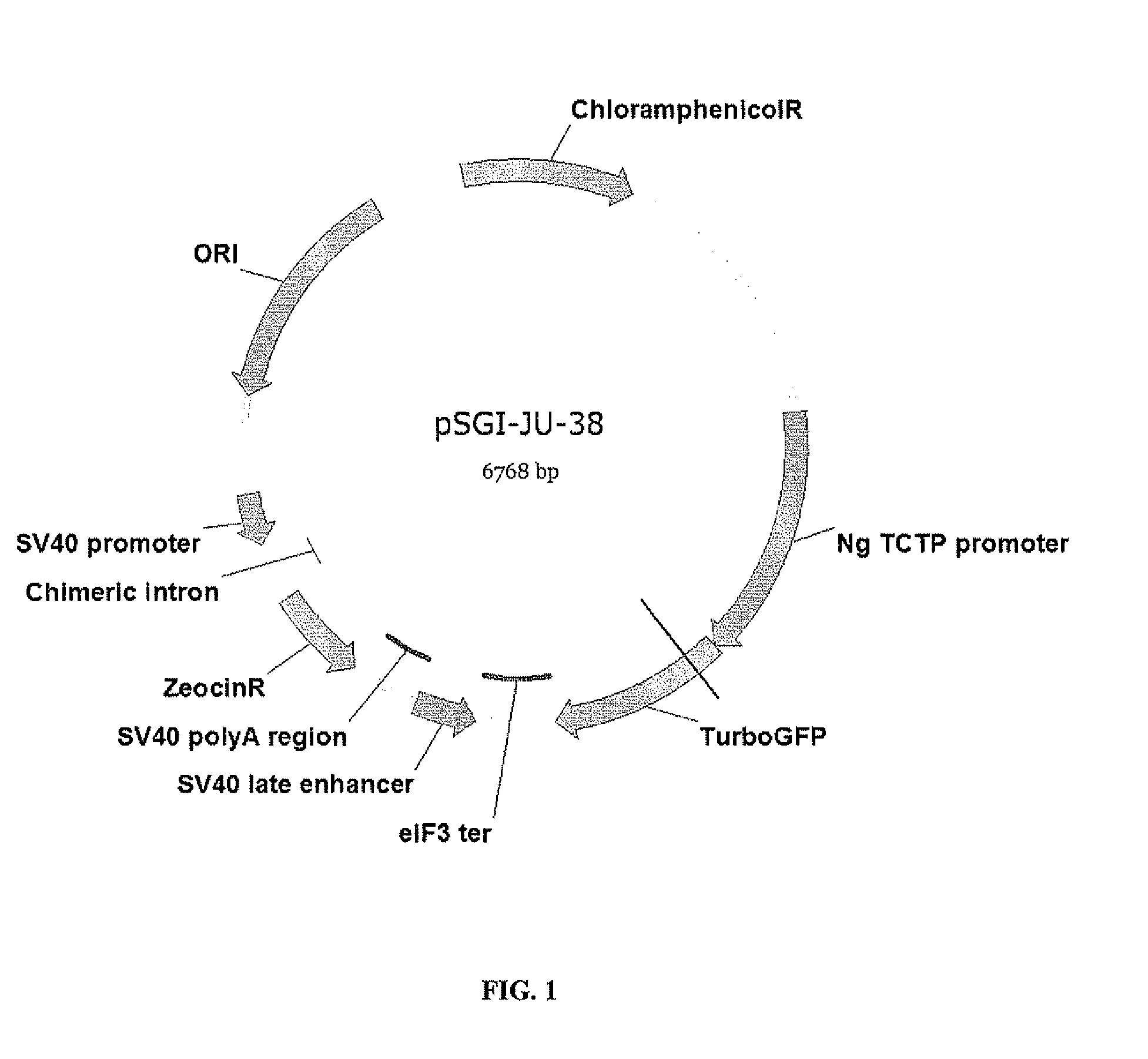Regulatory elements and uses thereof
a technology of regulatory elements and elements, applied in the field ofmolecular biology and genetic engineering, can solve the problems of difficult optimization of culture conditions for selected microalgal species, often constrained genetic modification of algae, etc., and achieve the effects of enhancing animal and human nutrition, high protein production, and modulating the phenotype of traits
- Summary
- Abstract
- Description
- Claims
- Application Information
AI Technical Summary
Benefits of technology
Problems solved by technology
Method used
Image
Examples
example 1
Identification and Isolation of Regulatory Elements from Nannochloropsis
[0149]Applicants of the present application identified and isolated polynucleotides having gene regulatory activity from the genome sequence data of the single-cell microalga Nannochloropsis gaditana. Briefly, whole-cell genomic DNA content of the microalgal strain N. gaditana CCMP1894, including nuclear and plastid genomes, was isolated and subsequently sequenced by using a whole-genome shotgun sequencing approach as described in PCT Patent Publication No. WO2010115156A2. Additionally, cDNA pools derived from Nannochloropsis cell culture were generated and sequenced by using the procedures described in US Pat. Publication No. US20110182862A1. After sequence assembly step, coding gene sequences were predicted from assembled contigs using an approach that combined evidence from multiple sources using the Evigan consensus gene prediction method as described previously by Liu et al. [Bioinformatics, March 1; 24(5)...
example 2
Construction of Recombinant Expression Cassettes Containing Regulatory Regions from Nannochloropsis
[0156]This Example describes the design and construction of expression cassettes and transformation vectors that were subsequently used to evaluate the promoter activity of several regulatory regions disclosed herein.
[0157]Briefly, each of the regulatory regions was operably cloned upstream of a reporter gene TurboGFP gene (Evrogen, Moscow, Russia) such that its ability to drive expression of the TurboGFP gene, i.e. promoter activity, could be subsequently tested and evaluated via green fluorescence analysis of recombinant Nannochloropsis cells upon genetic transformation. As positive control, a promoter region of the eukaryotic initiation elongation eIF3 of N. gaditana, which had been characterized previously, was used to drive TurboGFP expression in a transformation vector named pSGE05140.
[0158]pSGI-JU-38 is a plasmid for transformation of Nannochloropsis cells to express TurboGFP r...
example 3
Genetic Transformation of Nannochloropsis
[0164]Nuclear Transformation:
[0165]Nuclear transformations were carried out with algal cells of the Nannochloropsis gaditana strain CCMP1894. Cells were grown at 25° C. in L1−Si+10×N&P medium [i.e., L1 media (Guillard and Hargraves, Phycologia 32:234-236, 1993) without silica and with 10× concentration of nitrate and phosphate], 1% CO2, 100 μE light on a 16:8 light dark cycle with agitation using an orbital shaker that was set at 110 rpm. Log-phase cells (1-5×107 cells / mL) were harvested by centrifugation at 2,500×g at 25° C. for 10 min. The supernatant was decanted and cells were washed three times with 50 mL of 385 mM Sorbitol then resuspended at 1×1010 cells / mL in 385 mM Sorbitol. One hundred microliter of this cell suspension was mixed with linearized DNA (in a maximum volume of 10 μL) and transferred to a pre-chilled electroporation cuvette (0.2 cm gap). Electroporation of algal cells was performed with an electroporator that was set at...
PUM
| Property | Measurement | Unit |
|---|---|---|
| temperature | aaaaa | aaaaa |
| temperature | aaaaa | aaaaa |
| temperature | aaaaa | aaaaa |
Abstract
Description
Claims
Application Information
 Login to View More
Login to View More - R&D
- Intellectual Property
- Life Sciences
- Materials
- Tech Scout
- Unparalleled Data Quality
- Higher Quality Content
- 60% Fewer Hallucinations
Browse by: Latest US Patents, China's latest patents, Technical Efficacy Thesaurus, Application Domain, Technology Topic, Popular Technical Reports.
© 2025 PatSnap. All rights reserved.Legal|Privacy policy|Modern Slavery Act Transparency Statement|Sitemap|About US| Contact US: help@patsnap.com

